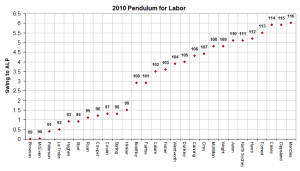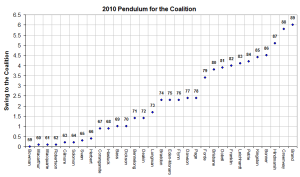Antony has the new pendulum for 2010 over on his site. What I thought was interesting about it was the chunkiness of the swings for seats for each party around the center of the pendulum – say, a 6% uniform swing each way. If we take Labor first and chart the seats they would gain with a given uniform swing (and note the seat number this would be for them in a new parliament) we get:
The 99th ALP seat would become Hinkler from a uniform swing to Labor of 1.5%. But to get the 100th seat – Boothby – the uniform swing required is 2.9%, nearly twice the swing of the 99th seat. That’s a lot of uniform swing for no action between 1.5 and 2.9.
For the Coalition we have:
For a very small swing, the Coalition picks up relatively large numbers of seats. Some of these are seats currently held by the Coalition anyway, but have been theoretically moved into the Labor column because of the redistributions. A 1% uniform swing would deliver them 70 seats in Parliament. To gain government outright, a swing of 2.3% is needed.
What’s worth mentioning about this, is that the broader electoral system still slightly favours the Coalition after the redistributions – with the Coalition needing 49.6% of the two party preferred to govern in their own right, 49% to govern with the support of the independents (assuming uniform swings).
You’ll also notice that Bowman is in each chart – that’s because nominally Bowman is pretty much a tie at the moment where any swing of a few tenths of a percent brings it nominally into that party’s column.
UPDATE:
Here’s the new pendulum as an image, with the seat name, the State it’s in, the margin (red for ALP, blue for Coalition) and the nth seat that would be for the ALP in any new Parliament assuming a uniform swing. You’ll notice that only 147 seats are listed – this is based on the assumption that the three independents will win regardless of what happens elsewhere.









Crikey is committed to hosting lively discussions. Help us keep the conversation useful, interesting and welcoming. We aim to publish comments quickly in the interest of promoting robust conversation, but we’re a small team and we deploy filters to protect against legal risk. Occasionally your comment may be held up while we review, but we’re working as fast as we can to keep the conversation rolling.
The Crikey comment section is members-only content. Please subscribe to leave a comment.
The Crikey comment section is members-only content. Please login to leave a comment.